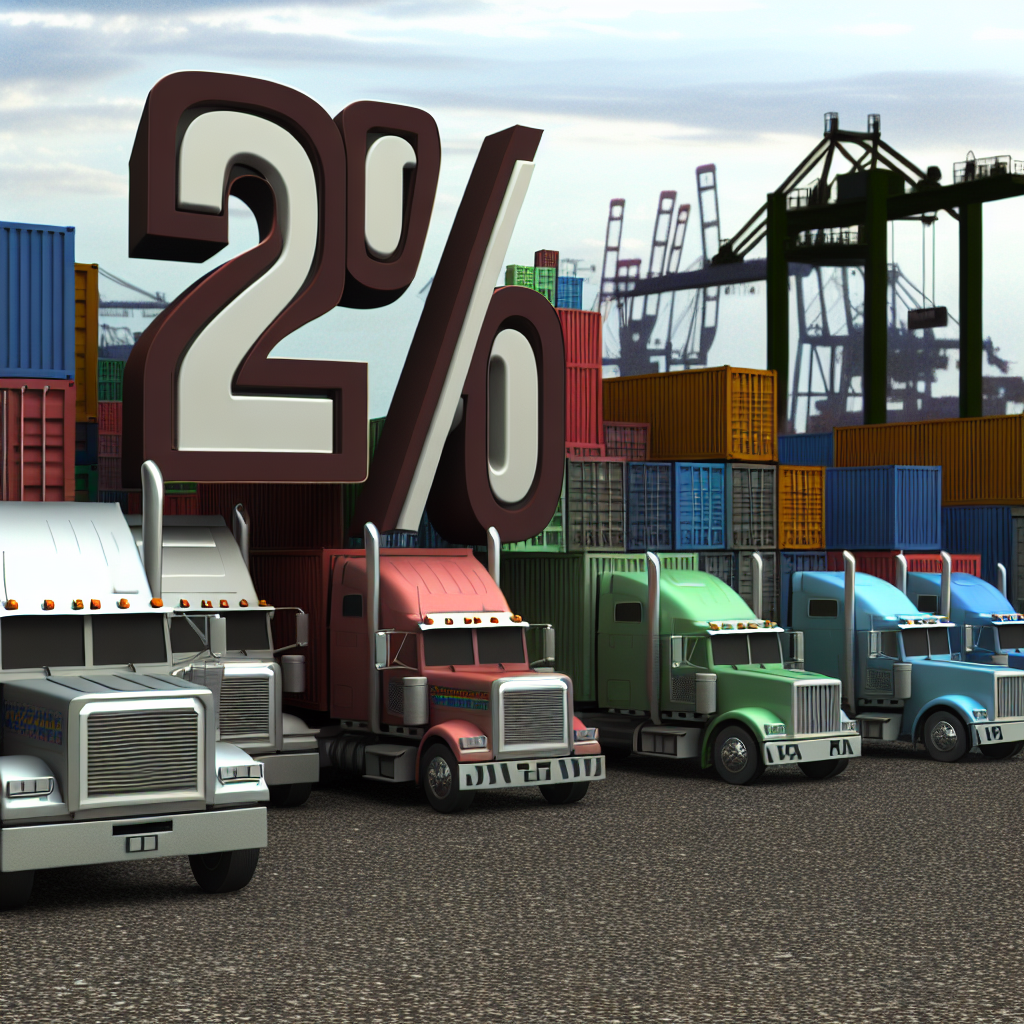As the global truck market gradually pulls out of the post-Covid hangover, Volvo Trucks finds itself at a critical juncture. With a solid reputation and an ambitious plan laid out in their Volvo Trucks growth strategy, the company aims to reclaim lost ground and capture more market share, particularly in North America.
Despite facing economic uncertainties and an aging fleet demographic, Volvo’s strategic investments in new models and production facilities signal a proactive approach to anticipated market recovery. This cautious optimism is echoed by industry experts, who recognize that while the road ahead may be fraught with challenges, the potential for growth is palpable.
With expectations for increased demand and a revitalized focus on innovation, Volvo Trucks is poised to navigate the complexities of the changing landscape and emerge stronger in the years to come.
Market Overview
The truck market is currently affected by older vehicles and changing demand. By 2025, commercial trucks in the U.S. have an average age of around 10.2 years, showing that fleets are becoming older due to ongoing market challenges and previous economic issues. The average age for regional haul trucks is 6.8 years, while linehaul units are about 6.4 years old.
Looking ahead, demand forecasts suggest a possible slowdown in recovery. In 2025, around 212,000 units are expected to be delivered, which is below the five-year order average of 285,000 units for North America. This downturn may stem from various economic influences, such as tariffs, emissions regulations, and a cautious approach from operators regarding fleet growth.
Volvo Trucks faces challenges as it aims to improve its position in this competitive market. The company has noted that the North American market might struggle until 2026, largely due to ongoing decreases in freight activity and new tariffs affecting costs. Regulatory uncertainties around emissions standards are also making fleet owners hesitant to invest in new trucks.
However, there are opportunities for Volvo as the market starts to stabilize and demand begins to rise again. Volvo’s focus on innovation, especially in electrification and self-driving technology, puts the company in a strong position to gain market share as these trends become more prominent. Additionally, Volvo’s strong presence in Greater Europe, where it holds a 19.6% market share, along with significant investments totaling US$2 billion in the new VNL model and US$400 million in production facilities, further enhance its ability to adapt and succeed despite challenges.
In conclusion, the truck market presents both challenges and chances for Volvo Trucks. With a proactive estrategia and a commitment to innovation, the company is well-prepared to handle uncertainties and pursue growth as the market recovers.
Competitive Landscape
The competitive landscape in the truck market as of late 2025 reveals a robust and challenging environment, particularly regarding Class 8 trucks. In North America, the market is primarily dominated by a few major manufacturers, which include Daimler Trucks (Freightliner), Paccar (Kenworth and Peterbilt), Navistar (International), and Volvo Trucks.
Key Competitors and Market Shares
- Daimler Trucks (Freightliner): Holding one of the most substantial market shares, Daimler remains a leading competitor in the Class 8 segment.
- Paccar: Along with its Kenworth and Peterbilt brands, Paccar showcases strong sales, continuously vying for a larger piece of the market.
- Navistar (International): Another key player that has maintained its standing in the market by updating its model offerings.
- Volvo Trucks: In 2024, Volvo Trucks achieved a market share of 10.5% in North America, an increase from 10.2% in the previous year. The company is leveraging innovation with the recent introduction of the new VNL model, which promotes fuel efficiency and performance.
Volvo’s Strategic Positioning
Volvo’s focus on North America is evident, as they aim to enhance brand presence and competitiveness by investing in new technologies and models. In 2024, they reported a 6% increase in truck orders, attributed to a strong demand in vocational trucks, despite facing a 5% decrease in deliveries due to transitioning to new models. Additionally, their heavy-duty market share is currently 7.2%.
In global markets, Volvo Trucks has further strengthened its position. They achieved a 17.9% market share in the European heavy-duty sector (16 tonnes and above) in 2024 and secured a 23.7% share in Brazil, demonstrating strong performance in Latin America.
Economic Factors Impacting Truck Orders
The competitive dynamics are further complicated by economic factors such as tariffs and regulatory compliance related to emissions. These aspects are creating apprehensive purchasing behaviors among operators, leading to cautious investing in fleet expansion. Volvo Trucks has recognized that challenges will persist yet anticipates recovering demand as market conditions stabilize.
Moreover, the electrification trend is becoming vital with Volvo leading the way in electric heavy-duty truck deliveries. The company reported over 5,700 electric truck deliveries across 50 countries by October 2025, showcasing their commitment to sustainable transport solutions. In North America, Volvo holds a considerable 30% market share in the electric truck segment, which positions them favorably in an evolving marketplace.
Conclusion
Overall, while Volvo Trucks is navigating a competitive landscape filled with challenges, their strategic investments in innovation, particularly in electric vehicles and sustainability, are paving the way for potential growth as it adapts to market demands. Volvo’s proactive stance amidst economic uncertainties signifies a determination to bolster their market position moving forward.
Market Share Comparison
The current market shares of Volvo Trucks in comparison with its competitors in North America and Greater Europe provide insight into their positioning within the truck market.
North America Market Share (2025)
| Manufacturer | Market Share (%) | Recent Strategies |
|---|---|---|
| Freightliner | 38.4 | Increased focus on heavy-duty truck sales with newer models coming in 2025. Source |
| Peterbilt | 14.8 | Continued emphasis on performance and fuel efficiency improvements. |
| Kenworth | 14.3 | Steady growth through innovative product offerings. |
| International | 11.6 | Incorporating advanced technologies in their fleet. |
| Volvo | 10.5 | Recently increased market share by introducing the new VNL model for better fuel efficiency. |
| Mack | 7.7 | Strengthening brand presence with new product variations. |
| Western Star | 5.4 | Targeting niche markets with specialized trucks. |
Greater Europe Market Share (2025)
| Manufacturer | Market Share (%) | Recent Strategies |
|---|---|---|
| Volvo Trucks | 17.9 | Leading with a focus on electric trucks and sustainable practices. Source |
| DAF Trucks | 14.4 | Strengthening their presence via technological advancements in heavy-duty trucks. Source |
| Mercedes | 18 | Focused on enhancing performance and driver comfort in their new line. Source |
| MAN | 14 | Aggressive marketing strategies for their latest truck models. |
| Iveco | 13 | Emphasis on flexibility and customization for different segments. |
| Scania | 12 | Competing with innovative technology and designs. |
| Renault | 9 | Focusing on expanding into electric trucks and low emission vehicles. |
These figures reflect the competitive dynamics in both North America and Greater Europe, where Volvo is working to bolster its stake amidst evolving market conditions and strategies.

Volvo’s Recent Investments
Volvo Trucks has recently undertaken significant investments aimed at enhancing production capacity and operational efficiency in North America.
New Heavy-Duty Truck Manufacturing Plant in Mexico
In April 2024, Volvo Group announced plans to build a new heavy-duty truck manufacturing plant in Monterrey, Mexico. This facility is expected to be operational by 2026 and will focus on producing heavy-duty conventional vehicles for both Volvo and Mack brands. The plant will be approximately 1.7 million square feet in size and will include comprehensive assembly capabilities, such as cab body-in-white production and painting. Source
Investment in New River Valley (NRV) Plant, Virginia
Volvo Trucks has completed a six-year, $400 million investment to upgrade its NRV plant in Virginia. This extensive upgrade was undertaken to prepare the facility for the production of the new Volvo VNL model. The enhancements include expanding the industrial footprint and installing state-of-the-art equipment aimed at improving plant efficiency and product quality. Source
Impact on Production Capacity and Operational Costs
- Increased Production Capacity: The new Monterrey plant will provide additional capacity to support the growth plans of both Volvo Trucks and Mack Trucks in the U.S. and Canadian markets, as well as support Mack truck sales in Mexico and Latin America. This expansion is expected to enhance Volvo’s ability to meet growing demand in these regions. Source
- Operational Efficiency and Cost Management: The strategic location of the Monterrey plant offers logistical efficiencies for supporting sales to the southwestern and western regions of the U.S., and to Mexico and Latin America.
Leadership Insights
Magnus Koeck, Vice President of Strategy, Marketing, and Brand Management at Volvo Trucks North America
Magnus Koeck has provided valuable insights into Volvo’s growth strategy, particularly as the truck market begins to recover from economic downturns. He emphasized the cyclical nature of the market, stating,
“The tide will turn. The question is, when the tide will turn,”
indicating a cautious optimism for future growth.
Koeck also highlighted the substantial investments being made in North America, noting,
“We aspire to grow a lot here in North America during the next business cycle,”
which underscores Volvo’s commitment to enhancing its market share with innovative products like the new VNL model.
In addressing sustainability, Koeck stated,
“Achieving a 10% improvement in fuel efficiency across the North American trucking industry would have a significant impact on decarbonization efforts, equivalent to removing 30,000 new battery-electric trucks from the road.”
Furthermore, he pointed out the pre-buy effects expected around the upcoming emissions regulations, firmly believing that,
“Signs of this pre-buy activity are already emerging,”
as operators look to adapt ahead of increased truck costs.
These insights reflect Volvo Trucks’ proactive strategies to enhance its position in the market while addressing evolving industry challenges.
Forecast Analysis: Navigating Challenges for Volvo Trucks
The road to recovery for the North American truck market appears fraught with challenges, significantly impacting Volvo’s strategic trajectory. As economic indicators signal a slow bounce-back from post-Covid disruptions, market forecasts have been adjusted to reflect a cautious outlook. Volvo now anticipates deliveries of 265,000 units in 2025, a downward revision indicative of prevailing economic uncertainties, fluctuating freight prices, and the anticipation of tighter regulations.
Economic Uncertainty
The U.S. and Canada are grappling with a freight market recession characterized by reduced volumes and prices. This scenario compels fleet operators to be more prudent in their purchasing decisions, leading to hesitation in expanding or upgrading fleets. Consequently, businesses such as Volvo Truck must remain agile and responsive to shifting market dynamics to maintain competitiveness.
Tariff Impacts
Recent tariffs have exacerbated the already complex market landscape. The laid-off workers in various Volvo facilities underscore the tangible consequences of declining market sentiment. This erosion of demand, relating partly to high tariffs on imported components, is prompting Volvo to reconsider operational strategies, potentially consolidating production and focusing on local supply chains to mitigate costs.
Emissions Regulations as a Double-Edged Sword
On the regulatory front, new emissions standards set to take effect in 2027 will further impact the market. While such regulations are essential for sustainable transport, they can also lead to price increases as manufacturers adapt their product lines. Historic trends suggest that customers may engage in pre-buying activities to avoid higher prices, which could result in short-term fluctuations in demand.
Volvo’s Strategic Response
In light of these considerations, Volvo Trucks is strategically positioning itself by investing heavily in innovation and operational efficiencies. The company’s recent investments in electric vehicle technology and sustainable practices are aimed at aligning with regulatory trends while enhancing their product appeal. For instance, Volvo’s focus on electric heavy-duty trucks has garnered notable interest, enabling it to maintain a 30% market share in this emerging segment despite broader market challenges.
In summary, while Volvo Trucks faces several substantial obstacles influenced by economic uncertainty, tariffs, and emissions regulations, its commitment to innovation and strategic investments provides a pathway for resilience and growth as the market recovers. This cautious yet proactive stance is vital for capturing future market opportunities as conditions begin to stabilize.
Projected Market Growth and Economic Indicators
To better visualize the anticipated market growth and its economic indicators, the following table summarizes key metrics that will impact Volvo Trucks in the upcoming years.
| Year | Projected Deliveries (Units) | Average Freight Prices (USD) | Market Growth Rate (%) | Economic Indicators |
|---|---|---|---|---|
| 2024 | 250,000 | 3,500 | -4.0 | Economic Tightening |
| 2025 | 265,000 | 3,200 | 1.2 | Slow Recovery |
| 2026 | 280,000 | 3,800 | 3.0 | Improved Economic Sentiment |
| 2027 | 300,000 | 4,000 | 4.5 | Positive Trade Balance |
| 2028 | 320,000 | 4,200 | 5.0 | Strong Market Demand |
This table reflects the gradual recovery of the market while accounting for fluctuating freight prices and overall economic indicators that affect the truck industry. By understanding these projected trends, Volvo Trucks can better strategize its operations and investments to align with market needs and enhance its competitiveness.

Conclusion
In summary, Volvo Trucks’ growth strategy is designed to position the company for significant market recovery as economic conditions gradually improve. With strategic investments in manufacturing capabilities and innovative product lines, such as the new VNL model, Volvo is set to enhance its market share in North America and beyond. The potential growth not only signifies a brighter future for the company but also for its stakeholders. Investors can look forward to robust returns as Volvo capitalizes on market opportunities. Employees may experience enhanced job security and growth prospects as production scales up. Suppliers can anticipate strengthened relationships and increased orders with Volvo’s commitment to innovation.
As customers benefit from advanced technologies and sustainable practices that align with their needs, a community of collaboration will spring forth from this shared vision of growth and responsibility. Insights from market analysis and industry leaders underscore the importance of agility in adapting to evolving market demands. As Magnus Koeck aptly stated, the company’s aspirations to thrive signify a persistent optimism amidst uncertainties. By fostering a sense of shared purpose among all stakeholders, Volvo Trucks not only shapes its own future but also champions a more sustainable and prosperous industry for all.
Key Takeaways from Market Overview and Competitive Landscape
- The truck market is recovering from economic downturns but faces challenges with an aging fleet, with average truck ages around 10.2 years in the U.S.
- Demand forecasts for 2025 indicate a modest recovery, expecting 212,000 units delivered, which is below the five-year order average of 285,000 units.
- Regulatory uncertainties and tariffs are creating a cautious investment climate among fleet owners, adding complexity to market recovery.
- Volvo Trucks’ market share in North America is currently 10.5%, showing a slight increase as they invest in innovation, particularly in the new VNL model.
- The competitive landscape includes major players like Daimler, Paccar, and Navistar, impacting Volvo’s strategies.
- Key opportunities exist in electrification trends, where Volvo has established a 30% market share in the electric truck segment.
- Despite market challenges, Volvo’s strategic commitment to innovation and sustainability positions it well for future growth.
Market Overview
- Reassess the aging truck fleet as representative of the larger trucking industry trends, noting that the average age of heavy-duty trucks has implications for fleet operators looking to modernize and invest in electric vehicle technology to replace older units.
Competitive Landscape
- When discussing competitors, emphasize how adapting to trucking industry trends and investing in electric vehicle technology is essential for maintaining competitiveness in the growing segment of heavy-duty trucks.
Volvo’s Recent Investments
- Highlight how Volvo’s investments in manufacturing are tailored to support the development of state-of-the-art electric vehicle technology, aligning with the shift towards more sustainable heavy-duty trucks.
Leadership Insights
- Incorporate visions regarding how trucking industry trends will shape future investment strategies, particularly how they pertain to the integration of heavy-duty trucks into a more electrified fleet.
The article’s content will remain relevant and engaging while ensuring higher keyword visibility. By embedding these keywords, the article will not only attract a targeted audience but will also improve its ranking in search engine results, contributing positively to Volvo Trucks’ overall digital marketing strategy.


